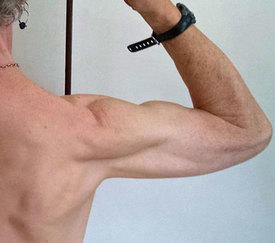Body measurements going down but fat % same?

Ok, so my weight is staying 163-165 the last two weeks. I weigh in every day to get a trend. My body measurements went slightly down, i do body measurements every 2 weeks. I plugged in measurements from two weeks ago and today's body measurements. I'm getting 27% fat for both calculations even though I went ever so slightly down everywhere(except my forearms, they went up 0.43 inch).
How is it my body measurements went down but my fat percentage estimate didn't even go down at all? Not even the slightest.🤔
Answers
-
Two weeks isn't long enough to figure out what average weekly results will be. Bodies are weird. Wait for at least 4-6 weeks on the same regimen to evaluate.
Also, remember that if weight goes down a few pounds, but body fat percent stays the same . . . you've lost fat, in pounds.
27% of a bigger number of body pounds is more fat pounds than 27% of a smaller number of body pounds.
Think about it. Example in round numbers:
30% body fat at 200 pounds = 60 pounds of fat.
30% body fat at 150 pounds = 45 pounds of fat.
Same principle applies even at smaller changes in body weight.
My advice: To evaluate body fat changes, always convert to pounds or kilos. Percents can mislead.
We see people here losing weight thinking they gained muscle because body fat percent dropped, when I'm reality the opposite was true. Another example:
Start: 30% body fat at 200 pounds is 70% lean mass, or 140 pounds lean mass.
End: 20% body fat at 150 pounds is 80% lean mass, or 120 pounds lean mass.
If a person had that start/end situation, they lost 20 pounds of lean mass alongside losing 30 pounds of fat, which may not be the goal they were really shooting for, and is probably not the grand result they're thinking.
Lean mass isn't exactly the same as muscle mass, but you get my point. Very generically we expect and even want to lose some lean mass when losing fat, but preferably not lots. 75% fat to 25% lean is a generic fairly average-good outcome. My example person above lost 60% fat, 40% lean. Not so great.
Always convert body fat percent to body fat pounds to avoid being mislead.
Best wishes!
2 -
How are you calculating fat% ?
1 -
Thank you for the information l, that makes total sense. I never thought of it all that way@AnnPT77
0 -
@tomcustombuilder I used a body fat % calculator online. It asks for all the measurements I took.
My smart scale says I'm %32.3 fat but I honestly think that is wrong. I heard body measurements and calculating it is more accurate.🤔
0 -
Honestly, any of the estimates we can make of body fat - short of autopsy, which isn't a good option for obvious health reasons - have an error rate. Some are closer than others, but all are imprecise.
It's a reasonable thing to track, but I'd suggest sticking with a consistent method of estimating, then watch the trend of it (converted to pounds 😉). If your estimated pounds of fat are dropping, and your estimated pounds of lean mass are dropping at a substantially slower rate, you're doing OK.
Even then, expect the body fat estimates to fluctuate up and down around a certain range, not be points on a straight line, because the estimating methods are a little squishy that way; and don't put a lot of stock in the absolute number being accurate.
You'll know when you feel and look the way you want to, right? Don't let some number run the show. That applies to specific body weight, body fat estimates, tape-measurements. Use the metrics to proceed in a positive direction trend-wise, and you'll know when you get where you want to be, as long as not afflicted with serious body dysmorphia. If in doubt, ask your doctor, not your friends. 😉
Personally, I also think it's fine to try various methods, and even try them all repeatedly . . . but not to compare one against the other, or try to construct a trend based on all of them at once. Separate trends for separate methods, if someone's that obsessed . . . which is probably a different problem in its own way, obsession-wise. 😆 For myself, when various wildly different estimating methods tend to converge in the same general range, I figure probably my body fat really might be in that general range . . . someplace.
1 -
waist measurement at the navel doesn't lie. For women hip measurements can be the way. If you measure both and track those thats about the best way to see if you're losing or not. Using calculators or smart scales can have a lot of variables that give you incorrect readings.
1 -
Speaking as a woman, I wouldn't suggest hip measurement - considered by itself - as a good indicator of body fat levels for women. Some of us do accumulate fat more around the hips, but it's not true for all. Moreover, some of us have widely-spaced pelvic bones, which also results in a bigger hip measurement, whereas others of us have narrower-set pelvic bones so a smaller measurement. That also affects hip measurement, not solely fat levels.
For most women, waist-to-hip ratio is a somewhat better, and even waist measurement alone would tend to be preferable as a health metric to hip measurement alone. I suspect the so-called Navy fat calculator online is better for predicting body fat than any of those, for women . . . the more measurement points taken into account, the better. That's because women tend to have more widely-distributed subcutaneous fat stores than men, and genetics may cause more or less fat to accumulate in particular ones of those areas.
I'm still going to encourage people not to obsess about body fat percent estimates.
1 -
hence why I said hip measurements CAN be the way to go for women not IS the way to go.
However I am in agreement that stressing over body fat % is a waste of time especially with some of these ways people go about trying to figure it. The mirror and photos and some measurements combined with the scale will tell you all you need to know. The way clothes fit also.
2 -
waist measurement at the navel doesn't lie.
It could lie when your navel is no longer where it used to be or where it is supposed to be! Which is probably the case with most morbidly obese, and quite possibly some obese, people who have lost a lot of weight. Not to neglect other reasons as to why belly buttons may move!
I've used, in the past, the WHO definition (halfway between the iliac crest and the lowest rib). However some reputable sites do suggest the top of the iliac crest which, since it is skipping the halfway business, would be lower! Keeping the tape straight and parallel to the ground would also make sense and is mentioned by some.
Which one is more "correct"…. well then. We would have to get back into a discussion of measurement errors and definitions and the fact that most of these measurements are intended to be "gross" SCREENING instruments that flag for "gross risk levels". They are not precise scalpels of deep meaning where that 0.5 cm means your artery will be severed and you will die from blood loss.
1 -
There are simple systems like the Navy method which has iirc three tape measurements, however there's still the issue of who is doing the measuring and how consistent it is. Skin caliper methods are better, but again the possibility of user error. Most home scales are useless. Possibly of limited value for trends only.
Even DEXA scans have flaws, and that's assuming you have access anyway. You can try hydrostatic weighing or an MRI, but good luck with the expense.
To sum up, don't stress over that number. Take progress pics, note how your clothes are fitting. If you're having to tighten your belt, things are probably moving in the right direction, especially if your shirts also feel tighter up top.
1
Categories
- All Categories
- 1.4M Health, Wellness and Goals
- 396.8K Introduce Yourself
- 44.2K Getting Started
- 260.8K Health and Weight Loss
- 176.3K Food and Nutrition
- 47.6K Recipes
- 232.8K Fitness and Exercise
- 450 Sleep, Mindfulness and Overall Wellness
- 6.5K Goal: Maintaining Weight
- 8.7K Goal: Gaining Weight and Body Building
- 153.3K Motivation and Support
- 8.3K Challenges
- 1.3K Debate Club
- 96.5K Chit-Chat
- 2.6K Fun and Games
- 4.5K MyFitnessPal Information
- 16 News and Announcements
- 18 MyFitnessPal Academy
- 1.4K Feature Suggestions and Ideas
- 3.1K MyFitnessPal Tech Support Questions



